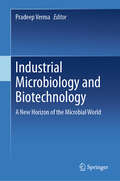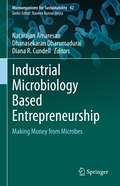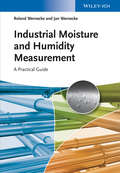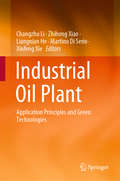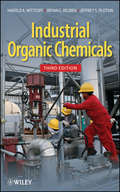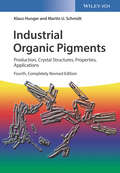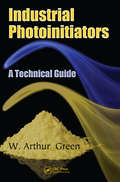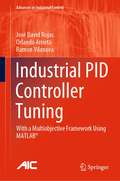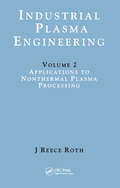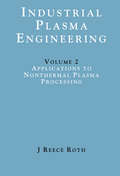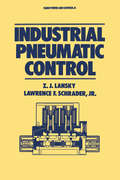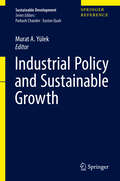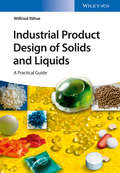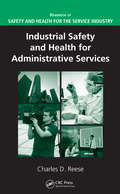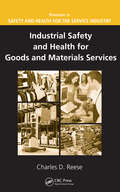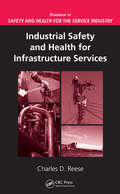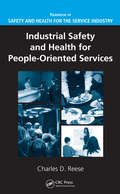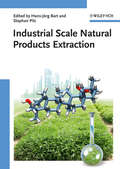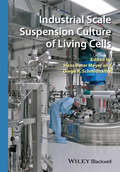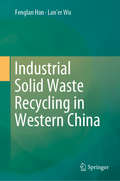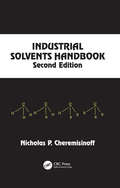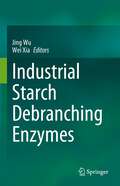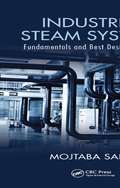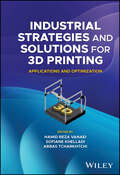- Table View
- List View
Industrial Microbiology and Biotechnology: A New Horizon of the Microbial World
by Pradeep VermaThis book is a comprehensive guide for industrial bioprocess development, covering major aspects of microbial processes and their role in biotechnology. It provides a selection of hyperproducers, microbial products, and metabolic engineering strategies for industrial production. It covers high cell density cultivation techniques product formation kinetics measurement and limiting parameters in large-scale process development. The first and second section of the book focuses on biotechniques, including spectroscopic concepts of light, wave, and electromagnetic theory, as well as absorption, fluorescence, phosphorescence, infrared, and Raman spectroscopy. It also covers the basic principles, concepts, biological applications, and other advanced techniques. The third section emphasizes microbial inventions and improvements in bioprocess development. It covers microbial products and recent developments in fermentation technology and also includes information on metabolic engineering. The fourth section related to microbial inventions and bioprocesses which include platforms for recombinant gene expression, as well as the development of recombinant heterologous expression systems such as E. coli, yeast, mammalian and insect cells, and plant cells used as biofactories. The fifth section of the book focuses on microbial product waste management in extreme environments, biomass waste management, bio-pulping, bio-bleaching, textiles, biofuels, and animal feed production. The book aims to provide a multidisciplinary opportunity on all aspects of microbial biotechnology. It covers recent international developments that have renewed interest in industrial microbiology and biotechnology. The book is suitable for teachers, researchers, graduate and post-graduate students, environmentalists, microbiologists, and biotechnologists.
Industrial Microbiology Based Entrepreneurship: Making Money from Microbes (Microorganisms for Sustainability #42)
by Natarajan Amaresan Dhanasekaran Dharumadurai Diana R. CundellThis book is first part of the 3 volume set focusing on basic and advanced methods for using microbiology as an entrepreneurial venture. This book deals with the concept of entrepreneurship skills for production, cost-benefit analysis and marketing of vaccines, diagnostic kits, biofuels, biogas, organic acids, plant nutrition enhancer, biofungicides, molecular products from Microbes-Taq polymerase, restriction enzymes and DNA ligase. Chapters cover the applications of microorganisms in small and large scale production to achieve a sustainable output. The book provides essential knowledge and working business protocols for Enzyme Industry, Pharmaceutical Industry, vaccine production etc. This book is helpful to graduate students, research scholars and postdoctoral fellows, and teachers who belong to different disciplines via botany, industrial microbiology, pharmaceutical and biotechnology, molecular biology. Other two volumes are focused on food and agriculture microbiology.
Industrial Moisture and Humidity Measurement
by Jan Wernecke Roland WerneckeMoisture analysis covers a variety of methods for measuring high levels of moisture, as well as trace amounts, in solids, liquids, or gases. There are many applications where trace moisture measurements are indispensable for manufacturing and for process quality assurance. Trace moisture in solids must be controlled for plastics, pharmaceuticals and heat treatment processes. Measurement applications in gases and liquids include, for example, drying processes, hydrocarbon processing, pure gases in the semiconductor industry, natural gas pipeline transport, the conditioning of food and other products.Written by experts with over 20 years of experience in the field, this one-stop guide covers all aspects of these measurements, including both the theory and a wealth of practical know-how. As such, it includes guidelines on installation, on the realization of standards for absolute and relative humidity, verification and traceability measurements, equipment calibration methods and the latest research developments.Backed by numerous case studies, this practical book serves the needs of those working in the industry tasked with performing or developing new techniques and processes for moisture and humidity measurement. As a result, the scientist or engineer has all the information required for accurate, reliable, economically viable and efficient moisture measurement.
Industrial Oil Plant: Application Principles and Green Technologies
by Changzhu Li Zhihong Xiao Liangnian He Martino Di Serio Xinfeng XieThis book systematically explains the application principles and green processing technologies of industrial oil plant. Firstly, the industrial plant oil resources are elaborated as an independent discipline for systematic research. Secondly, it has laid a solid theoretical foundation for the utilization of industrial plant oil resources, and will greatly promote the development of industrialization and modernization of industrial plant oil resources worldwide. Thirdly, it constructs integrated technology system of oil plant cultivation, oil extraction technology and products application. Finally, it elaborates a series of environmental issues including the protection of biodiversity and the balance of the forest ecology during the industrial plant oil resources processing. The technological process for green conversion of industrial plant oil resources to the oil-based materials and high value products will be of particular interest to the readers among oil researchers, producers and managers.
Industrial Organic Chemicals
by Harold A. Wittcoff Bryan G. Reuben Jeffrey S. PlotkinAn essential introduction to the organic chemicals industry--in the context of globalization, advances in technology, and environmental concerns Providing 95 percent of the 500 billion pounds of organic chemicals produced in the world, the petroleum and natural gas industries are responsible for products that ensure our present quality of life. Products as diverse as gasoline, plastics, detergents, fibers, pesticides, tires, lipstick, shampoo, and sunscreens are based on seven raw materials derived from petroleum and natural gas. In an updated and expanded Third Edition, Industrial Organic Chemicals examines why each of these chemical building blocks--ethylene, propylene, C4 olefins (butenes and butadiene), benzene toluene, the xylenes, and methane--is preferred over another in the context of an environmental issue or manufacturing process, as well as their individual chemistry, derivatives, method of manufacture, uses, and economic significance. The new edition details the seismic shifts in the world's chemistry industry away from the United States, Western Europe and Japan, transforming the Middle East and Asia-Pacific region, especially China, into major players. The book also details: The impact of globalization on the patterns of worldwide transportation of chemicals, including methods of shipping chemicals The technological advances in the area of polymerization and catalysis, including catalyst design and single-site catalysts Chemicals for electronics, with much new material on conducting polymers, photovoltaic cells, and related materials The discovery of vast reserves of shale gas and shale oil, altering long-term predictions of resource depletion in the United States and other countries Commercial and market aspects of the chemical industry, with coverage of emerging new companies such as INEOS, Formosa Plastics, LyondellBasell, and SABIC With expanded coverage on the vital role of green chemistry, renewables, chemicals and fuels on issues of sustainability and climate change, Industrial Organic Chemicals offers an unparalleled examination of what is at the heart of this multi-billion dollar industry, how globalization has transformed it, and its ever growing role in preserving the Earth and its resources.
Industrial Organic Pigments: Production, Crystal Structures, Properties, Applications
by Klaus Hunger Martin U. SchmidtRevised and updated, this highly acclaimed work, now in its fourth edition, remains the most comprehensive source of information available on organic pigments. It provides up-to-date information on synthesis, reaction mechanism, physical and chemical properties, test methods, and applications of all the industrially produced organic pigments available on the world market. This fourth edition now includes new chapters on the latest applications and three-dimensional X-ray analysis, while the chapters on legislation, ecology, and toxicology have been rewritten to reflect recent developments. Sets the international standard for information on the synthesis, reaction mechanisms, properties, relevant test methods, and applications of organic pigments Contains all industrially produced pigments of the world market, even those which can no longer be found in producers’ catalogs are described Standardized methods allow test results to be compared throughout the book The reader is given useful hints as to which pigment is best for a given application Clearly structured and concise text with up-to-date references to the pertinent literature Ecological and toxicological properties of organic pigments are outlined Appendix offers invaluable flow diagrams on the manufacture of numerous pigments, a table of all described pigments with information about their C.I. and CAS registration, and an in-depth subject index
Industrial Photoinitiators: A Technical Guide
by W. Arthur GreenThe use of photoinitiators in the UV curing process shows remarkable possibilities in myriad applications. Highlighting critical factors such as reactivity, cure speeds, and application details, Industrial Photoinitiators: A Technical Guide is a practical, accessible, industrially oriented text that explains the theory, describes the products, and
Industrial PID Controller Tuning: With a Multiobjective Framework Using MATLAB® (Advances in Industrial Control)
by José David Rojas Orlando Arrieta Ramon VilanovaIndustrial PID Controller Tuning presents a different view of the servo/regulator compromise that has been studied for a long time in industrial control research. Optimal tuning generally involves comparison of cost functions (e.g., a quadratic function of the error or a time-weighted absolute value of the error) but without taking advantage of available multi-objective optimization methods. The book does make use of multi-objective optimization to account for several sources of disturbance, applying them to a more realistic problem: how to select the tuning of a controller when both servo and regulator responses are important. The authors review the different deterministic multi-objective optimization methods. In order to ameliorate the consequences of the computational expense typically involved in their use—specifically the generation of multiple solutions among which the control engineer still has to choose—algorithms for two-degree-of-freedom PID control are implemented in MATLAB®. MATLAB code and a MATLAB-compatible program are provided for download and will help readers to adapt the ideas presented in the text for use in their own systems. Further practical guidance is offered by the inclusion of several examples of common industrial processes amenable to the use of the authors’ methods. Researchers interested in non-heuristic approaches to controller tuning or in decision-making after a Pareto set has been established and graduate students interested in beginning a career working with PID control and/or industrial controller tuning will find this book a valuable reference and source of ideas.Advances in Industrial Control reports and encourages the transfer of technology in control engineering. The rapid development of control technology has an impact on all areas of the control discipline. The series offers an opportunity for researchers to present an extended exposition of new work in all aspects of industrial control.
Industrial Plasma Engineering: Volume 2: Applications to Nonthermal Plasma Processing
by J Reece RothWritten by a leading expert in the field, Industrial Plasma Engineering, Volume 2: Applications to Nonthermal Plasma Processing provides a background in the principles and applications of low temperature, partially ionized Lorentzian plasmas that are used industrially. The book also presents a description of plasma-related processes and devices tha
Industrial Plasma Engineering, Volume 2: Applications to Nonthermal Plasma Processing
by J Reece RothWritten by a leading expert in the field, the paperback edition of Industrial Plasma Engineering, Volume 2: Applications to Nonthermal Plasma Processing provides a background in the principles and applications of low temperature, partially ionized Lorentzian plasmas that are used industrially. The book also presents a description of plasma-related processes and devices that are of commercial interest. The text is suitable for students or in-service users with a physics and calculus background at the sophomore level. These two volumes are intended to be used as textbooks at the senior or first-year graduate level by students from all engineering and physical science disciplines and as a reference source by in-service engineers.
Industrial Pneumatic Control
by Z.J. LanskyThis book provides detail on pneumatic directional control valve and regulator and pneumatic circuitry. It emphasizes on component construction and function, as well as the installation, maintenance, and troubleshooting of malfunctioning components. It is useful to plant and design engineers.
Industrial Policy and Sustainable Growth
by Murat A. YülekThis volume looks at the critical issues of industrial policy and sustainability. It assesses the gap between how developed and developing countries have integrated sustainability issues in their industrial policies, and how they should have ideally done so. The book looks at the specific issues of middle income trap, levels of industrialization and the distribution of manufacturing activities among nations, and presents analysis of sector and country specific policy case studies in areas such as health, energy, medical devices, aviation, automobile manufacturing. The volume also examines trade policies and their impact on industry and environment, and elaborate on how industrial policies involve selective direct and indirect sectoral policies which play a role in assisting policy makers manage objectives of catch up and sustainability.
Industrial Process Identification and Control Design
by Furong Gao Tao LiuIndustrial Process Identification and Control Design is devoted to advanced identification and control methods for the operation of continuous-time processes both with and without time delay, in industrial and chemical engineering practice. The simple and practical step- or relay-feedback test is employed when applying the proposed identification techniques, which are classified in terms of common industrial process type: open-loop stable; integrating; and unstable, respectively. Correspondingly, control system design and tuning models that follow are presented for single-input-single-output processes. Furthermore, new two-degree-of-freedom control strategies and cascade control system design methods are explored with reference to independently-improving, set-point tracking and load disturbance rejection. Decoupling, multi-loop, and decentralized control techniques for the operation of multiple-input-multiple-output processes are also detailed. Perfect tracking of a desire output trajectory is realized using iterative learning control in uncertain industrial batch processes. All the proposed methods are presented in an easy-to-follow style, illustrated by examples and practical applications. This book will be valuable for researchers in system identification and control theory, and will also be of interest to graduate control students from process, chemical, and electrical engineering backgrounds and to practising control engineers in the process industry.
Industrial Product Design of Solids and Liquids
by Wilfried RähseOffering invaluable insights from a chemist with over 35 years experience in the industry, this practical guide incorporates numerous practical examples and case studies to explain the concepts included here.The author explains the processes involved in product design, how to set up experiments, and ultimately how to scale-up. Among the host of topics covered is a discussion of recent advances in the fundamentals and innovative technologies leading to new and improved products.Industrial Product Design of Solids and Liquids: A Practical Guide is essential reading for the pharmaceutical, cosmetics and personal care, food, fragrance, paints, plastics and agricultural industries.
Industrial Safety and Health for Administrative Services (Handbook of Safety and Health for the Service Industry)
by Charles D. ReeseIndustrial Safety and Health for Administrative Services constitutes a much-needed source for the identification and prevention of most of the injuries and illnesses occurring in the financial and information sectors. The text thoroughly explains the issues of office health management, major safety and electrical hazards, and emergency response to
Industrial Safety and Health for Goods and Materials Services (Handbook of Safety and Health for the Service Industry)
by Charles D. ReeseIndustrial Safety and Health for Goods and Materials Services focuses on the safety requirements of the wholesale and retail trades, including warehousing. This detailed text describes the hazards associated with chemicals, compressed gases, and fire. In addition to discussing the ergonomics behind hand tools, ladders, machine guarding, material ha
Industrial Safety and Health for Infrastructure Services (Handbook of Safety and Health for the Service Industry)
by Charles D. ReeseIndustrial Safety and Health for Infrastructure Services provides an in-depth look into the areas of transportation, utilities, administrative, waste management, and remediation. It covers OSHA regulations in reference to the major safety and health hazards associated within these five fields. This user-friendly text:Provides guidance on removal, d
Industrial Safety and Health for People-Oriented Services (Handbook of Safety and Health for the Service Industry)
by Charles D. ReeseIndustrial Safety and Health for People-Oriented Services focuses on the safety requirements of the tertiary sector of industry's education, health, and hospitality services. This is an instruction manual on managing a safe and healthy environment- one free of biological, chemical, and ergonomics hazards - while adhering to OSHA regulations. In add
Industrial Scale Natural Products Extraction
by Hans-Jörg Bart Stephan PilzCovering the latest technologies in process engineering, this handbook and ready reference features high pressure processing, alternative solvents and processes, extraction technologies and biotransformations -- describing greener, more efficient and sustainable techniques. The result is an expert account of engineering details from lab-scale experiments to large-scale industrial design. The major focus is on the engineering aspects of extraction with organic and supercritical solvents, ionic liquids or surfactant solutions, and is supplemented by aspects of both up- and downstream processing, biotransformation, as well as a survey of typical products in food, pharmaceutical and cosmetic applications. This is rounded off by market developments, economic considerations and regulations requirements in the field Authored by experts from leading industrial and academic institutions, this is essential reading for the hands-on scientist and office manager alike.
Industrial Scale Suspension Culture of Living Cells
by Diego Schmidhalter Hans-Peter MeyerThe submersed cultivation of organisms in sterile containments or fermenters has become the standard manufacturing procedure, and will remain the gold standard for some time to come. This book thus addresses submersed cell culture and fermentation and its importance for the manufacturing industry. It goes beyond expression systems and integrally investigates all those factors relevant for manufacturing using suspension cultures. In so doing, the contributions cover all industrial cultivation methods in a comprehensive and comparative manner, with most of the authors coming from the industry itself. Depending on the maturity of the technology, the chapters address in turn the expression system, basic process design, key factors affecting process economics, plant and bioreactor design, and regulatory aspects.
Industrial Solid Waste Recycling in Western China
by Fenglan Han Lan'er WuThis book introduces the latest results in research and practice of industrial solid waste recycling in China's western regions, where more than 50% of the waste in the whole country was produced. With rapid development in recent years, the massive industrial solid waste has become a serious problem in China. This book summarizes information and results of several National Research Programs of China concerning the typical solid wastes of the metallurgical and energy industry in western China, such as magnesium slag, manganese slag, acid sludge of lead and zinc smelting, fly ash, steel slag and carbide slag. It will be highly beneficial to scholars and engineers of environmental science and engineering.
Industrial Solvents Handbook, Revised And Expanded
by Nicholas P. CheremisinoffKeeping pace with current trends in solvent production, this volume builds upon its previous edition with broader coverage of safe handling practices, health effects, physical properties, and chemical synthesis routes to some of the most important organic solvents used in the chemical and allied process industries. This handy reference features a glossary of solvent terminology and an easy-to-reference index of synonyms for chemicals and solvents. The Second Edition features new and updated chapters on the major classes of organic solvents, descriptions for general use, and the chemical formulation, thermodynamic properties, health and toxicity, and combustible characteristics of solvents.
Industrial Starch Debranching Enzymes
by Jing Wu Wei XiaThe book presents a systematic and detailed introduction on starch debranching enzymes concerning the classification, biochemical properties, features on sequences and structures, enzyme engineering, production, and current applications. All relevant contents are organized to focus on characteristics, productions and industrial applications of the starch debranching enzymes. It is purposed to deepen the understandings on the pre-existing researches, developments, and bottlenecks, and also to discuss the research hotspots and application perspectives of starch debranching enzymes. The book is written for researchers, professional/practitioners and graduate students in the field of enzymology, microbiology, and food science etc.
Industrial Steam Systems: Fundamentals and Best Design Practices
by Mojtaba SabetThis clear, easy-to-follow handbook is a useful resource for engineers, architects, and plant operators. A one-stop reference for beginners and advanced readers alike, it describes industrial steam systems design and operation in simple steps. The book explains the system fundamentals, system setup, and required equipment, building, mechanical, and other code requirements, and details the execution of a sample project. It also explains the equipment operation principle and describes best design practices for system setup, piping and instrumentation, equipment sizing, pipe sizing, and equipment selection.
Industrial Strategies and Solutions for 3D Printing: Applications and Optimization
by Hamid Reza Vanaei Sofiane Khelladi Abbas TcharkhtchiINDUSTRIAL STRATEGIES AND SOLUTIONS FOR 3D PRINTING Multidisciplinary, up-to-date reference on 3D printing from A to Z, including material selection, in-process monitoring, process optimization, and machine learning Industrial Strategies and Solutions for 3D Printing: Applications and Optimization offers a comprehensive overview of the 3D printing process, covering relevant materials, control factors, cutting-edge concepts, and applications across various industries such as architecture, engineering, medical, jewelry, footwear, and industrial design. While many published books and review papers have explored various aspects of 3D printing, they often approach the topic from a specific perspective. This book instead views 3D printing as a multidisciplinary field, extending beyond its rapid growth into emerging areas like data science and artificial intelligence. Written by three highly qualified academics with significant research experience in related fields, Industrial Strategies and Solutions for 3D Printing: Applications and Optimization includes information on: Role of various 3D printing features in optimization and how machine learning can be used to further enhance optimization processes Specific optimization techniques including physico-chemical, mechanical, thermal, and rheological characteristics Steps for transitioning of 3D printing from the laboratory scale to industrial applications in fields such as biology, turbomachinery, automotive, and aerospace Challenges related to the controlling factors for in the optimization purpose, along with in-process monitoring of 3D printing for optimal results and output Industrial Strategies and Solutions for 3D Printing: Applications and Optimization is a valuable and up-to-date reference on the subject for researchers, scholars, and professionals in biomedical, chemical, and mechanical engineering seeking to understand foundational concepts related to the free-form fabrication approach and how to achieve optimal results.
